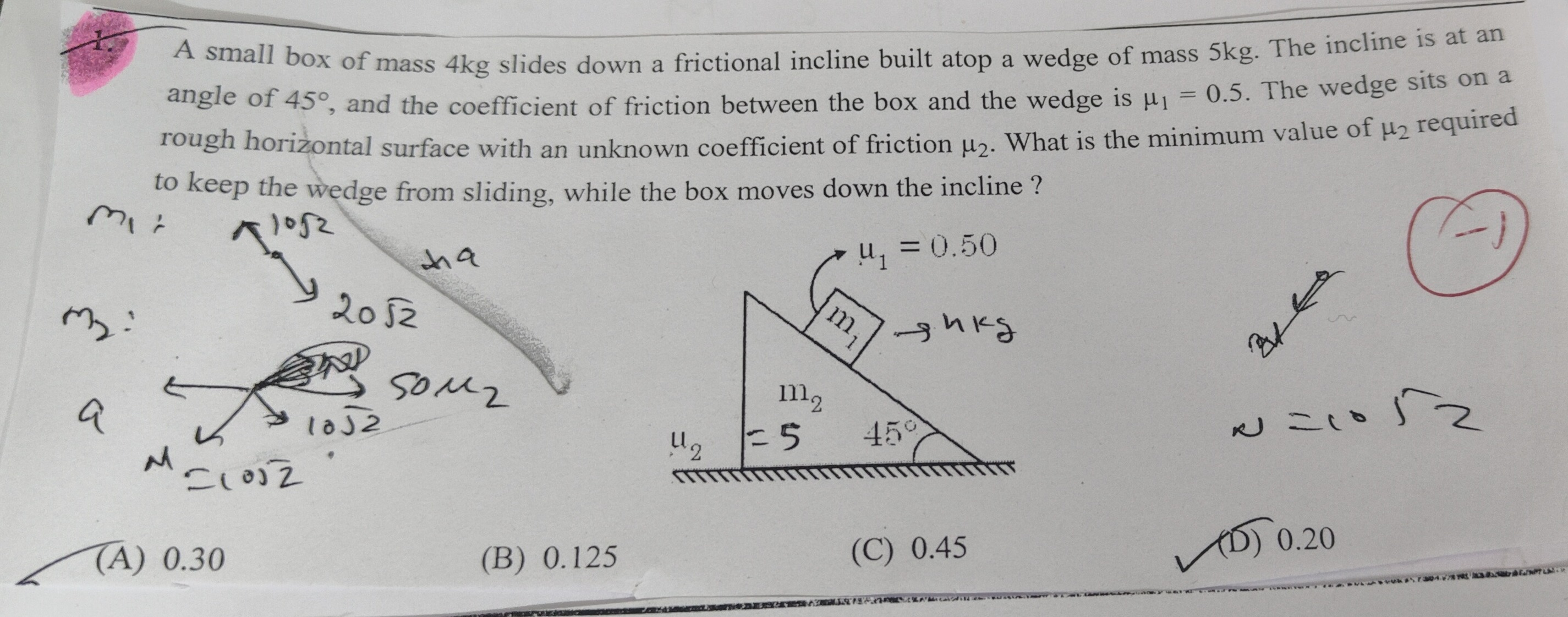Question
Question: A small box of mass 4kg slides down a frictional incline built atop a wedge of mass 5kg. The incline...
A small box of mass 4kg slides down a frictional incline built atop a wedge of mass 5kg. The incline is at an angle of 45°, and the coefficient of friction between the box and the wedge is μ1=0.5. The wedge sits on a rough horizontal surface with an unknown coefficient of friction μ2. What is the minimum value of μ2 required to keep the wedge from sliding, while the box moves down the incline ?

0.30
0.125
0.45
0.20
The correct answer is 0.375, which is not among the options provided. There seems to be an error in the options.
Solution
To find the minimum value of μ2 required to keep the wedge from sliding, we need to analyze the forces acting on both the box (m1) and the wedge (m2). The wedge is in equilibrium, meaning the net force on it is zero.
Given:
- Mass of box, m1=4kg
- Mass of wedge, m2=5kg
- Angle of incline, θ=45∘
- Coefficient of friction between box and wedge, μ1=0.5
- Acceleration due to gravity, g=10m/s2
Step 1: Forces on the Box (m1)
- Normal force (N1): N1=m1gcosθ=4×10×cos45∘=202N
- Frictional force (f1): f1=μ1N1=0.5×202=102N
Step 2: Forces on the Wedge (m2)
The wedge is stationary, so the net force on it is zero. The forces exerted by the box (m1) on the wedge (m2) are:
- Normal force N1′: Equal in magnitude to N1 but acts perpendicular to the incline, into the wedge.
- Frictional force f1′: Equal in magnitude to f1 but acts parallel to the incline, downwards along the incline.
Resolve N1′ and f1′ into horizontal and vertical components:
- Horizontal component (to the right): N1sin45∘=202×21=20N and f1cos45∘=102×21=10N
- Vertical component (downwards): N1cos45∘=202×21=20N and f1sin45∘=102×21=10N
Apply equilibrium conditions for the wedge:
- Vertical equilibrium: N2=m2g+N1cos45∘+f1sin45∘=(5×10)+20+10=80N
- Horizontal equilibrium: f2=N1sin45∘+f1cos45∘=20+10=30N
Step 3: Calculate the minimum μ2
For the wedge to be on the verge of sliding: μ2=N2f2=8030=0.375
The calculated value of μ2=0.375 is not among the options.
